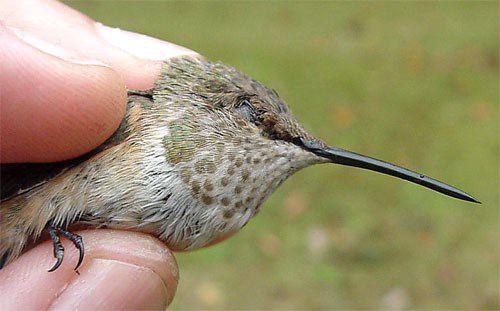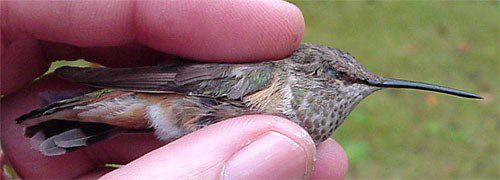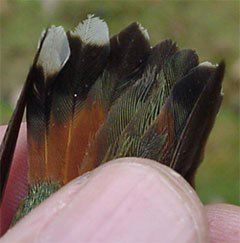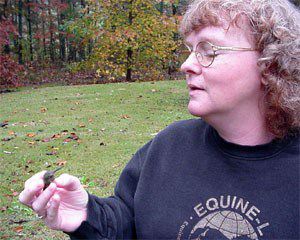 HOME: www.hiltonpond.org |
|||
|
RUFOUS HUMMINGBIRD |

All text & photos © Hilton Pond Center Hollis Barnes lives 'way off in Tamassee--almost as far north and west as you can go in South Carolina without being in Georgia or North Carolina. Hollis is a true hummingbird lover who hosts dozens of Ruby-throated Hummingbirds in summer, so she was aware that having a November hummingbird at her place in the Blue Ridge northwest of Clemson was out of the ordinary--especially since her bird looked like it could be some other species. When Hollis did a Web search for hummingbird experts, Hilton Pond Center for Piedmont Natural History popped up on her computer, so she e-mailed us to indicate her desire to have the bird identified and banded.
At 4 a.m. on 10 November 2002 from the Center near York, we set sail toward the northwestern corner of South Carolina, arriving at Tamassee (Oconee County) as the clock struck 7 a.m. and shortly after the skies had dropped torrential rains. As is often the case, Hollis reported her hummer had been on the feeder just ten minutes before our arrival, so we went inside the house as we determined the best place to erect our portable hummingbird trap.
The view from the living room revealed that the hummer had already returned and was casually lapping up sugar water from a perch on the feeder. As soon as the bird left, we moved Hollis's feeder into our hummer trap, hung the whole apparatus on the front porch, and retreated back inside to await another visit by the bird. Within five minutes it came back, buzzed the trap, investigated the release mechanism on top, probed an attached piece of red wire, and disappeared. A few minutes later it repeated this behavior, never going anywhere near the entry door to the trap. At 7:20 a.m. it made one more visit to the trap; instead of entering it, however, it fed briefly at a nearby orange-red Canna Lily and zipped off into the drizzling rain. Even without having the hummer in-hand, we could see rusty color that indicated it definitely was not a Ruby-throat.
Sitting and observing a deployed hummingbird trap can be like watching the proverbial pot that doesn't boil, and literally nothing happened at the feeder for the next hour--or for the 15 minutes after that. Finally, at 8:40 a.m. we announced authoritatively--but with a slight degree of sarcasm--that we believed the best way to get this hummingbird to return was to stop watching the trap and answer nature's call, so we left the observation window and wandered down the hall to Hollis' bathroom. Incredibly, a minute after we shut the door we heard Hollis call out loudly that the hummingbird was in the trap. We rushed back to the living room, saw that Hollis wasn't kidding, immediately hit the trigger button, and caught the hummingbird while it continued to feed. (Note To Other Hummingbird Banders: If you have trouble capturing hummers in the future, quit watching your trap and go to the bathroom. It's a technique that seems to work and that deserves further investigation. Perhaps we can collaborate on a journal article about the usefulness of the privvy in trapping hummingbirds.)
Vital Statistics for Rufous Hummingbird #Y14815
Age/Sex--Hatch year female After banding, we hand-fed the hummer with a last hit of sugar water and photographed Hollis as she released her western vagrant back into the wild. Needless to say, we instantly gathered up our trapping gear, got directions to Pendleton, cranked the engine on the van, and sped off to investigate this latest report of more winter hummingbirds. For details of our next adventure, read further at Pendleton SC Hummingbird.
If you're interested in sharing your hummingbird observations and learning from other enthusiasts, you may wish to subscribe to Hummingbird Hobnob, our Yahoo!-based discussion group. Also be sure to visit our award-winning Web site for Operation RubyThroat: The Hummingbird Project; on it you'll find almost anything you want to know about hummingbirds, including more information about Hummingbird Banding.
For much more information about hummingbirds, visit Operation RubyThroat: The Hummingbird Project |



 Up close it appeared that our new capture was a female or young male Rufous Hummingbird, but measurements were required to be sure it wasn't a similar-looking but slightly smaller Allen's Hummingbird. The combination of wing chord and tail lengths removed all doubt and confirmed that Hollis's bird was indeed a Rufous, and the round, white tip on the next-to-interior tail feather made it a young bird hatched in 2002. Another indication that it was a young female was the complete lack of metallic orange-red gorget feathers; by November, adult females and young males typically have one or more of these iridescent markings, but Hollis's bird had only pale green feathers on the throat. Interestingly, this bird--like one we trapped last week at Charlotte but unlike all the others we have banded--kept both its eyes tightly closed for the entire banding process.
Up close it appeared that our new capture was a female or young male Rufous Hummingbird, but measurements were required to be sure it wasn't a similar-looking but slightly smaller Allen's Hummingbird. The combination of wing chord and tail lengths removed all doubt and confirmed that Hollis's bird was indeed a Rufous, and the round, white tip on the next-to-interior tail feather made it a young bird hatched in 2002. Another indication that it was a young female was the complete lack of metallic orange-red gorget feathers; by November, adult females and young males typically have one or more of these iridescent markings, but Hollis's bird had only pale green feathers on the throat. Interestingly, this bird--like one we trapped last week at Charlotte but unlike all the others we have banded--kept both its eyes tightly closed for the entire banding process. Hollis had invited friends to spend the previous night so they could observe the whole trapping/banding procedure, and one of them mentioned that her mother--who lives 20 miles away in Pendleton SC--is a hummingbird enthusiast who would be interested in hearing about our success with Hollis's bird. When a phone call was made, the mother innocently said, "Oh, I still have a couple of hummingbirds, too, doesn't everyone?"
Hollis had invited friends to spend the previous night so they could observe the whole trapping/banding procedure, and one of them mentioned that her mother--who lives 20 miles away in Pendleton SC--is a hummingbird enthusiast who would be interested in hearing about our success with Hollis's bird. When a phone call was made, the mother innocently said, "Oh, I still have a couple of hummingbirds, too, doesn't everyone?"
 Students at GLOBE-certified schools may submit winter hummingbird observations as part of Operation RubyThroat and GLOBE. Students can also correlate hummingbird observations with data on abiotic factors, including atmosphere, climate, hydrology, soils, land cover, and phenology. See the
Students at GLOBE-certified schools may submit winter hummingbird observations as part of Operation RubyThroat and GLOBE. Students can also correlate hummingbird observations with data on abiotic factors, including atmosphere, climate, hydrology, soils, land cover, and phenology. See the 



